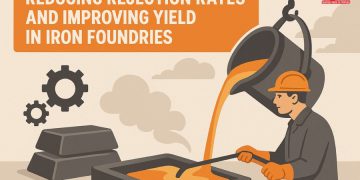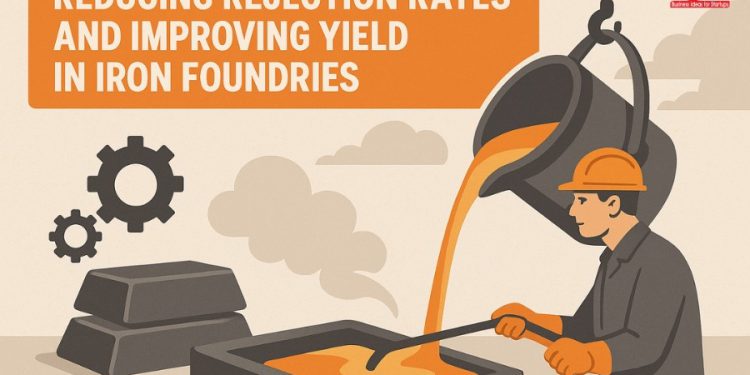In the Ductile Iron and Cast Iron Foundries, their productivity, profitability, and brand reputation suffer from high rejection rates and low yields. Furthermore, these foundries work under the never ending strain of customer requirements, which makes the precision of products, their structural integrity, and delivery time very important.
Every foundry faces some challenges at one point or another. For iron foundries, the copper mining industry, automotive industry, and agricultural industry places high standards on them. Not only is a strict adherence to dimensional tolerances, metallurgical standards, and surface quality benchmarks mandatory, but also competition drives the need for superior logistics and supply chain models.
The NPCS insights in the article will be useful for foundries aiming towards shifting to a leaner and modern profitable practice. This article also delves into the specifics of the quality control structure designed for cast and ductile iron foundries, focusing on proving ways to lower rejection rates and optimize yield. A systematic approach to managing foundry quality control involves root cause identification along with effective measure implementation.
Foundry Defect Analysis for Iron Foundries
Every quality control plan must start from somewhere. Iron foundries are unique among all other manufacturing industries because their rejection rates tend to be higher. This can be attributed to the sheer complexity of the foundry process. It includes multiple interrelated steps: melting, alloying, mold making, pouring, solidification, mold shakeout, and finishing. Each of these processes has numerous variables, for e.g., temperature, composition, sand quality, and cooling rate, and each may have small fluctuations that could spell disaster and result in large scale casting defects such as:
- Gas porosity and blow holes
- Internal and external shrinkage defects
- Cold shuts and misruns
- Excessive Sand and metal penetration
- Cracking
- Deformed Shape
- Inconsistent Microstructure
Automation is one of the main contributors to such errors, as well as the lack of control of raw materials and obsolete machinery and tools. Also, without proper operation procedures, the margin for error expands greatly. A ductile or grey Iron Foundries is likely to report an average rejection rate of 8-12 %, and those on the more advanced side of the spectrum, termed world class foundries, strive to keep it below 3-5%. Even a modest reduction of 1% can lead to tremendous cost savings and increased productivity along with improved plant efficiency.
The Significance of Strategic Quality Control in Foundry Operations
As with every other branch of manufacturing, QC in ductile iron and cast iron foundries is not a post-mortem inspection—it should be a constant at every phase. A strategic framework for QC considers quality as a part within the manufacturing system hierarchy, which begins from raw material procurement to final shipment. It allows for having a predictive monitoring system for root cause analysis, real-time corrective feedback, and process improvement mechanisms.
An effective QC strategy should aim at:
- Meeting the specified standards regarding the metallurgical and dimensional accuracy of the castings supplied.
- Meeting the scrap and rework cost targets.
- Achieving the required metal and material yield.
- Improving customer satisfaction while decreasing warranty claims.
- Compliance and certification with regulatory and industry standards (ISO, IATF)
If all foundries adopted a comprehensive quality approach, it would allow them to move from reactive firefighting to proactive defect prevention.
Related: Environmental and Infrastructure Initiatives in India’s Chemical Sector
Iron Foundry Quality Control Framework Basic Features
1. Control of Charge Composition and Raw Materials
The first step toward achieving quality is with the charge material. foundries need to establish stringent procurement policies and supplier audits geared towards ensuring the chemical purity of base iron, steel fresh, and ferroalloys. Contamination from a variety of elements, such as phosphorus, sulfur, and aluminum, is referred to as “tramp elements” and can adversely impact structure.
The calculation of the charge should be performed methodically taking into account factors like loss of melting, formation of slag, and specific targets on carbon, silicon, magnesium (for ductile iron), and other alloying elements to be included. Automated spectrometers should be employed for the chemical analysis of molten metal during the most crucial phases.
Niir Project Consultancy Services (NPCS) provides foundry-focused customization feasibility study reports that contain thorough raw material scouting, supplier planning, and optimization of metal recovery techniques.
2. Managing Sand Mold and Core Quality
The majority of casting inaccuracies approxmtly stem from substandard core and molding methods. Continuous monitoring of sand quality with respect to grain size, permeability, binder proportion, and moisture content is essential.
Standardized methods in core setting accuracy, control of core baking temperature, venting design, and balancing of forces impacts various defects intended, penetrating effects like decreased performance efficiency bounds on cold shuts, metal congestion, and capture within mold gaps control various gaps along with capture below core.
For early detection of sand-related inconsistencies, sand testing laboratories equipped with compactability testers, moisture measuring devices, and strength testing devices offer advanced warning.
3. Melting and Pouring Parameters
For iron, reaching a melting temperature is not merely an achievement, but a consistently maintained atmosphere within the furnace, prevention of slag build-up, controlled carbon pick-up, and appropriate alloy dissolution all factor into it. Each of these processes require standard operating procedures along with temperature monitoring techniques, whether it be an induction furnace, a cupola, or an electric arc furnace.
Gas entrapment, porosity, and coolant streams are possible from ineffectively managed pre-heating of ladles and pouring temperature. For ductile iron, magnesium treatment is included, along with a specific timing of reaction control and content of ferro-silicon-magnesium specified for nodule formation and ductile mechanical properties sculpted.
Melting labs integrated with clean thermal analyzers allow some foundries to outperform others consistently due to a melting defect and consistency in the resulting cast.
4. Defect Prevention Optimization Design and Control
A common issue in both cast iron and ductile iron structures are internal voids brought about with improper managing of solidification and its associated factors. Without a correctly implemented cooling system combined with proper cooling to gates ratio, uncrafted outer voids, alongside uncontrolled shrinkage and hot tearing arise.
The modern foundry resorts to adopting a test run of the mold the software bound to design risers and set cooling thresholds for the basic structure frame outline with added ductile materials. Performing simulations like these allows accurate finishing of marked defect areas with closure and control of solidification along with directional flow pathways for engineered design parameters. NPCS’s DPRs already include simulation casting suggestions and vendor collaborations which allow even smaller foundries to implement sophisticated planning systems with minimal capital expenditure.
5. In-process and Final Inspection Protocols
Inspection is smarter than simply discarding the inferior parts; it involves gathering useful information. Primary quality control checkpoints at foundries incorporate:
- Defect identification through visual inspection of castings
- Dimensional inspection using gauges or CMM (Coordinate Measuring Machine)
- Microstructure examination through metallography
- Tensile strength and hardness testing
- NDT (Non-destructive testing) Ultrasound (UT), Magnetic Particle Inspection (MPI), or X-ray
Creating SPC (Statistical Process Control) charts enables monitoring of certain measurements, thus enabling preemptive actions before a lot is out of control. All results of inspections should be captured electronically for ease of tracking, reporting, and audits by customers.
Yield Optimization within Foundries: Transforming Scrap into Financial Benefits
In foundries “yield” is defined in reference to the volume of liquid metal turned into acceptable finished castings to the portions consumed by runners, risers, and scraps caused by defect or excessive machining. Iron foundries typically have a yield of 60-75% but best in class plants can achieve 85%.
Yield improvements can be made by:
- Minimizing over-design in gating and riser systems.
- Reducing the riser volume utilizing exothermic risers or sleeves.
- Sprue and riser returns can be efficiently recycled.
- Machining allowance reduction by designing near-net-shape castings.
- Mold layout optimization to incorporate multiple cavities into single molds.
NPCS assists foundries with layout design, yield improvements, and process flow diagrams detailing the use of the metal in all stages.
Integration of People, Process and Technology
In the absence of skilled operators, accountably culture, and rigorous attention to foundries quality manuals, even the best quality systems fail. Foundries need to retrain operators, define work instructions visually, and cultivate ownership of quality throughout the production chain. Cultural transformation can be accomplished through continuous improvement methodologies such as 5S, Kaizen, Six Sigma and Total Productive Maintenance (TPM).
With digitization, the availability of mobile inspection devices, and quality real-time dashboards, supervisors can monitor trends and act swiftly. Even small and mid-sized foundries can adopt Industry 4.0 paradigms with the more affordable IoT sensors attached to a cloud data system.
As part of comprehensive consulting packages, NPCS assists clients in planning lean manufacturing alongside primary quality digitization pilot projects.
Financial Change Resulting From Quality Improvement Efforts
Quality improvement does require an upfront expenditure, but the positive effects on profitability can be notable. For instance, a foundry that makes 1000 tonnes of ductile iron casting a year:
- A reduction in rejection rates from 10% to 5% can yield material and rework savings of ₹50 to 60 lakh per year.
- Improvement of yield from 70% to 80% reduces raw material costs by approximately ₹1 crore annually.
- Decreased scrap rates lessen melting energy and manpower.
- Increased product quality improves customer satisfaction and repeated business.
- Also, achieving consistent quality is mandatory for ISO/IATF certification and for accessing export markets which have strict compliance with technical requirements.
NPCS And Their Role In Transforming A Foundry Into A World Class Facility
Niir Project Consultancy Services (NPCS) has more than 40 years of experience in the planning and execution of industrial projects focusing on metallurgy and manufacturing and is NPCS’s area of specialization. Their services are aimed at aiding the modernization and competitiveness of iron foundries.
NPCS offers:
…and many more
Customs SOPs:
- Melting SOP
- Pouring SOP
- Inspection SOP
- And more
Drafting Business Plans in Preparation for ISO/IATF Audits
Consulting on Government Subsidy Schemes for the Modernization of MSME Units
With NPCS as your project partner, you not only build a profitable operation but also gain a roadmap for long-term growth, efficiency, and sustainability.
Closing Statement: From Defects to Excellence—The Foundry’s Journey
In today’s globalized marketplace, improving the rejection rate and yield in a ductile iron or cast iron foundry lies at the intersection of manufacturing strategy and absolute necessity. Forged foundries need to get rid of the relics of outdated and inefficient practices and frameworks. It’s 2023. Quality and precision cut command the market, and so do data, technology, and finely tuned execution.
The journey every highly rejected, low yield operation has to pivot toward lean and profitable manufacturing starts with an absolute adherence to quality, process, and perpetual educational evolution. With serene methods along with proper backed mindset and guidance from NPC’s, even small and medium foundries will stand to surge to global competitiveness in iron casting.


























